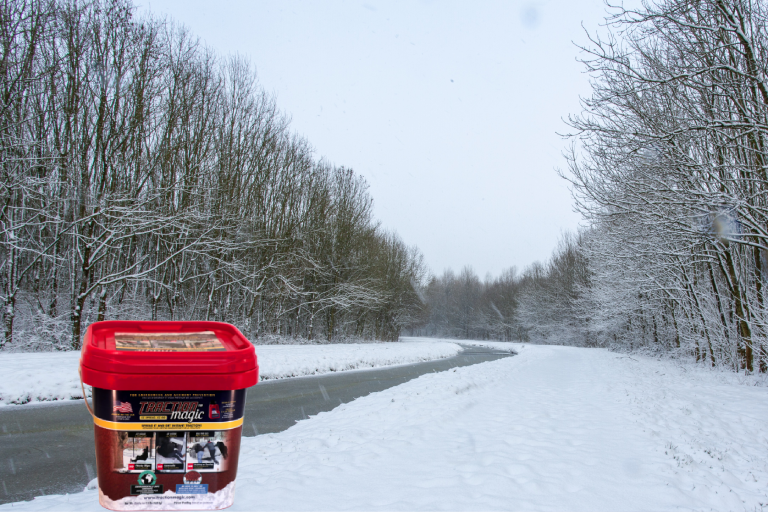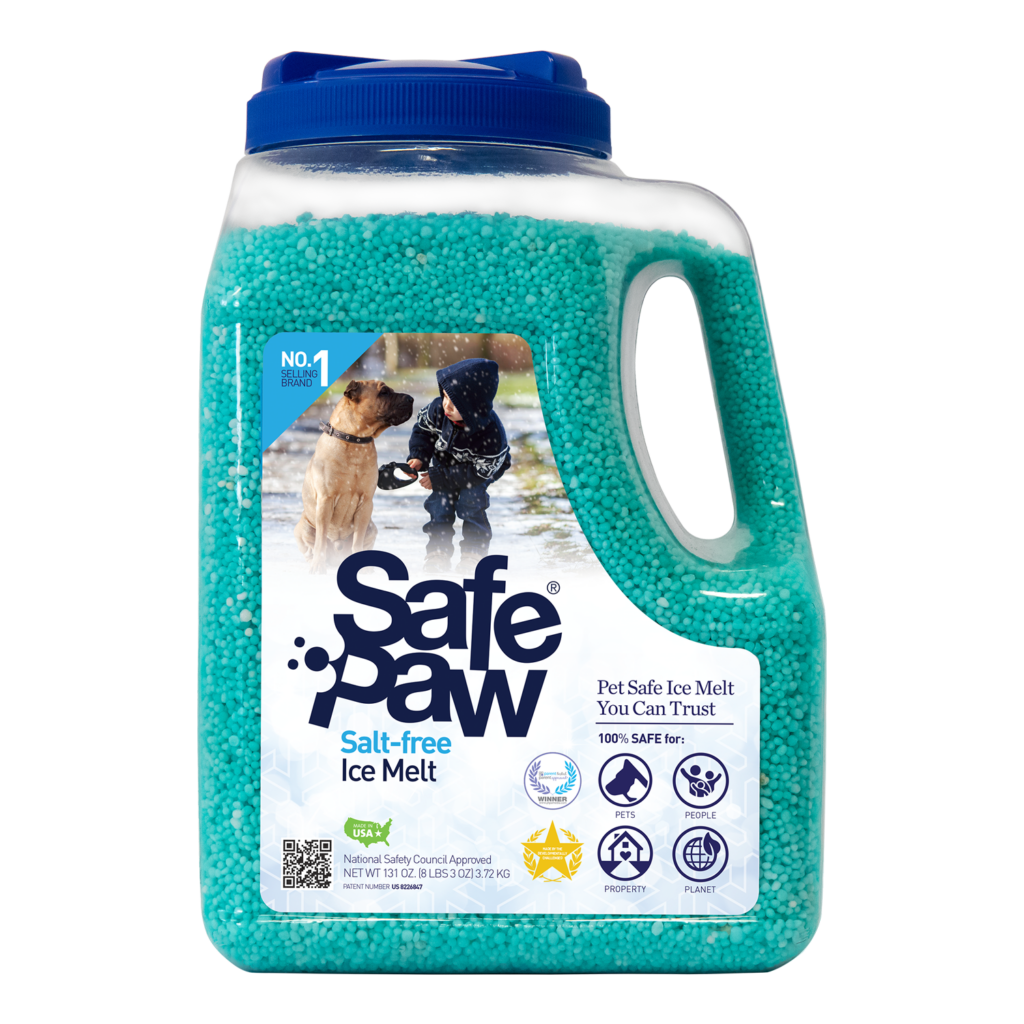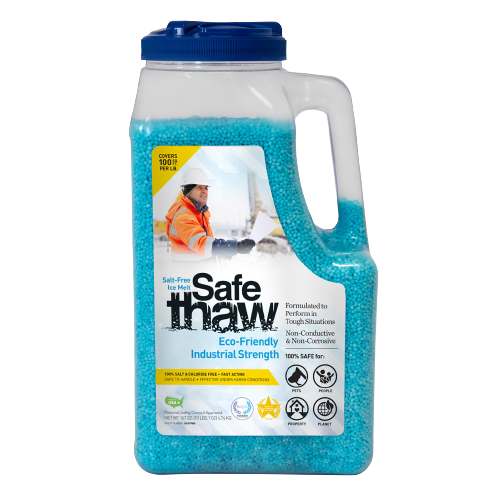Best Ice Melt or Traction Agent for New Concrete

Are ice melt products safe for new concrete? What about fully cured concrete? This guide to ice problems on concrete has the answers.
Keeping Your Home Safe
Every homeowner wants to keep their household safe from slips on the ice because falls on icy surfaces result in injury almost 30 percent of the time:
- Broken bones (in more than 5 percent of falls)
- Concussion (falls are the number-one cause)
- Death (falling is the leading cause of injury-related death in the elderly)
- Sprains, tendon tears and bruising
Pet are susceptible to being injured on ice in many of the same ways.
Reducing Premises Liability
There’s a secondary reason for maintaining slip-free concrete walkways, steps, and porch: reducing the liability risk of a stranger, neighbor, delivery person or anyone else falling on your property. Premise liability is the basis for tens of thousands of injury lawsuits every year at a cost of millions of dollars to homeowners.
The most common cause of falling outside a home is ice. When the homeowner has had adequate time to remedy the ice issue but fails to, he or she is liable for injuries sustained when someone slips on it.
Get ready for winter with Traction Magic instant grip on snow and ice
Using Ice Melter on New Concrete
Concrete experts warn that no ice melt product should be used on concrete that has not fully cured. While your concrete contractor might tell you that concrete cures in 28 days this isn’t the whole story. It’s true that concrete can be sealed after four weeks. However, chemical changes take place and the concrete continues to harden for much longer.
How does ice melt damage new concrete?
Ice melt and other deicers lead to a problem called “spalling” in which the top layer of concrete begins to disintegrate and flake off. The problem can be widespread on concrete or first appear as pitting in isolated spots.
Why does spalling occur? The main reason is freeze and thaw cycles. Concrete is porous, so water penetrates its surface, though not very deeply. When that water freezes, it expands with enough force to crack the concrete on a microscopic level like it cracks a glass jar when it is filled with water and frozen. The more that deicers are used, the more freeze/thaw cycles occur – and the worse the pitting and spalling issues are.
Unsealed concrete and material that aren’t fully cured are highly susceptible to spalling because moisture penetrates more deeply. That’s why you should never use ice melt on new concrete. It causes the freeze/thaw cycles that do the damage!
Get ready for winter with Traction Magic instant grip on snow and ice
Using Ice Melt on Older Concrete
While concrete that is a few years old or older is as hard as it is going to get, its surface is still susceptible to damage from frequent freeze/thaw cycles. It simply doesn’t make sense to spread salt or other ice melters on concrete, new or old.
What Ice Melt is Safe on Concrete?
When it comes to selecting an ice melt safe on concrete, it’s important to consider products that won’t cause damage or deterioration (new concrete ice melt). Ice melts that are chloride-free are typically recommended, as chloride-based products can contribute to concrete corrosion over time. Look for alternatives that prioritize safety for both the environment and your concrete surfaces.
How Do You Melt Ice Without Damaging Concrete?
Protecting your concrete while melting ice requires a careful balance. Traditional rock salt may melt ice but can harm your concrete. Instead, consider alternatives like ‘Traction Magic,’ an anti-skid solution that creates a skid-free and slip-free surface without causing any harm to your concrete.
Ensuring Safety on Icy Concrete with Traction Magic
A dilemma has been exposed: You want to keep your household safe and yourself free from liability risk, but you don’t want to ruin expensive concrete! There is a way to cover all the bases.
Salt alternative Traction Magic is not a deicer. Instead, it covers icy surfaces with a gritty, secure layer to provide better footing than any other substance can. How does Traction Magic work? The proprietary formula works in two ways:
- Absorbers siphon water from the ice’s surface. From physics, we know that ice liquefies when compressed, as when someone walks on it, creating a layer of water that makes ice extremely slick. The absorbers are the solution. They absorb the water immediately.
- Gripper granules with many-sided spiked surfaces dig into the ice on contact in a way that standard grains of sand don’t have the shape for.
The grippers working with the absorbers produce a dry, stable non-slip surface for you, your household, your pets, and anyone who walks on your property.
Where to Use Traction Magic?
Try Traction Magic at home or where you work. Carry a bucket of Traction Magic in your car to provide instant traction for your tires if you get stuck. It will provide safe footing when you arrive home or at your destination in icy conditions.

When to Use Traction Agent and When to Use Ice Melt for Concrete Safety?
Knowing when to use a traction agent versus an ice melt product is essential for maintaining concrete safety during winter. Here’s a guideline to help you make the right choice:
- Traction Agent: Use a traction agent, like sand or gravel, when you need to provide immediate grip on icy surfaces. These materials don’t melt the ice but create a gritty surface that enhances traction.
- Ice Melt: Opt for new concrete ice melt products when you need to both melt ice and ensure safety. ‘Traction Magic’ is an excellent example of an ice melt solution that not only enhances traction but also preserves the integrity of your concrete surfaces.
Concrete Safety in Focus: Do Ice Grip Winter Boots and Traction Control Help?
When it comes to managing ice risks on foot or behind the wheel, equipment plays a vital role—especially when paired with a proper surface treatment like Traction Magic. But it’s worth addressing a few common questions: does traction control help on ice, and what role do ice grip winter boots play?
Ice grip winter boots offer a physical layer of defense, giving wearers much-needed stability on slippery surfaces. But without proper surface treatment underneath, even the best boots can fall short. That’s where traction agents come into play—boots grip better when the ground provides something to grip onto. On untreated ice, even high-end boots may skid.
When driving, people often ask: does traction control help on ice? The answer is yes—but only to a point. Traction control systems help prevent wheel spin, which is useful on icy roads. However, if your tires have nothing to grip, such as on untreated black ice traction or slick inclines, traction control alone won’t save the day. This is where external traction aids, like Traction Magic, come in. What to do when you lose traction on ice, placing a traction agent under your tires can help regain control almost instantly. So, whether you’re walking with the best boots or navigating with high-tech vehicle systems, surface prep still matters. Knowing how to gain traction on ice is about pairing personal or vehicle safety tools with smart surface treatments.
Conclusion
Choose Traction Magic for a winter that’s not only safe but also respectful of your concrete surfaces. With its anti-skid formula and all-natural composition, you can enjoy icy wonders without compromising on safety or sustainability. Beyond being an excellent solution for new and old concrete alike, Traction Magic also empowers your winter gear—whether it’s boots or traction control—by giving them the surface they need to perform. Unlike traditional ice melts that worsen spalling or rust your rebar, Traction Magic offers true peace of mind. It works instantly, doesn’t rely on temperature, and won’t leave behind a corrosive mess. This winter, choose smarter traction—not just for safety, but for the long-term protection of your surfaces, your environment, and your peace of mind. Walk, drive, and work with confidence. You’ll never need to second guess your steps again. That’s the power of true winter-ready traction.
FAQs
Other Ice Melt Products
Safe Paw
The Original and the #1 Pet and Child Safe Ice Melt for over 20 years. Guaranteed environmentally safe – will not harm waterways and sensitive wetlands. Safe Paw can change how winter affects our planet.

Safe Thaw
Imagine an ice melt you can put down and never worry about. It won’t harm pets, kids and your property. That’s Safe Thaw. Unlike anything else on the market, Ice and Snow Management You Can Trust.
